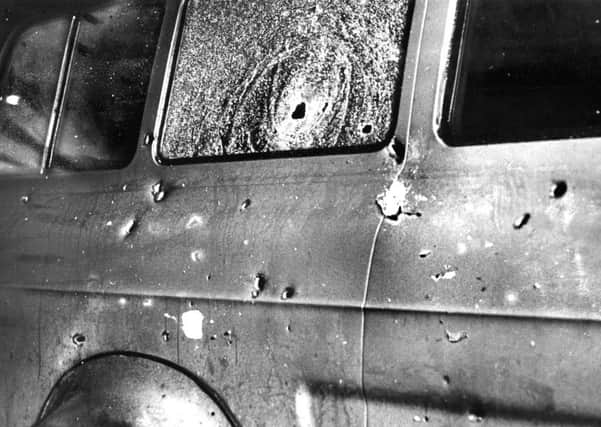Man will not be prosecuted over Kingsmill massacre palm print


Northern Ireland’s Public Prosecution Service (PPS) said there was “insufficient evidence” to offer a reasonable prospect of convicting the individual arrested on suspicion of murdering 10 Protestant workmen in the 1976 outrage.
The ten victims were lined up on a country road in rural south Armagh and shot dead in a sectarian attack that was widely blamed on the IRA. Another man survived despite being shot 18 times.
Advertisement
Hide AdAdvertisement
Hide AdMichael Agnew, the PPS’s Assistant Director of Central Casework, said lawyers had given “careful consideration to all of the evidence” and had applied the test for prosecution.
“We have concluded that there is no reasonable prospect of a conviction based on the available evidence and that the test for prosecutions is therefore not met,” he said.
It is understood a lack of Garda and Royal Ulster Constabulary (RUC) records in regard to how the van was forensically handled upon discovery was a key factor in the PPS’s decision.
Prosecutors could apparently not find documents indicating exactly when the vehicle was found, or where it was taken for examination, or even the precise location of the palm print position on the windscreen.
Advertisement
Hide AdAdvertisement
Hide AdSo while prosecutors did not perceive matching the print to the individual as an issue, the missing forensic records meant they were unable to rule out that the palm might have been placed on the windscreen well after the shootings.
While the PPS did have two witnesses identifying the green Bedford van as being in the general vicinity both before and after the attack, the sightings were not close enough to the scene to provide strong circumstantial evidence.
The already long-delayed inquest into the Kingsmill murders was again put on hold last year with the dramatic announcement that detectives had apparently matched the print to an individual.
Three months later a 59-year-old man was arrested in Newry, Co Down.
Advertisement
Hide AdAdvertisement
Hide AdThe man, who had previous terror convictions, was released pending a police file being sent to prosecutors for assessment.
At a subsequent inquest hearing, a lawyer for the Police Service of Northern Ireland (PSNI) said detectives believed the print belonged to the arrested man.
Mr Agnew announced the decision on Thursday.
“We are mindful of the disappointment that this decision will bring to the surviving victim and families of those who were killed,” he added.
“Although 41 years have passed since this atrocity, we are conscious that their pain endures.
Advertisement
Hide AdAdvertisement
Hide Ad“We have informed the families this morning of our decision and the reasons for it, and have offered to meet with them to answer any further questions that they may have.
“We are also conscious that inquest proceedings are currently adjourned to allow for any criminal matters to be concluded and accordingly have advised the coroner of this decision.”
The textile workers were shot when their minibus was ambushed outside the village of Kingsmill on their way home from work.
Those on board were asked their religion, and the only Catholic was ordered to run away.
Advertisement
Hide AdAdvertisement
Hide AdThe killers, who had been hidden in the hedges, forced the 11 remaining men to line up outside the van before opening fire.
Alan Black was the sole survivor.
The suspected getaway vehicle was left abandoned across the Irish border and the palm print was subsequently recovered days later.
No-one has ever been convicted of the murders, which have been widely blamed on the IRA, even though the organisation never admitted responsibility.
The attack was seen as a reprisal for loyalist killings in the same area days earlier.
Advertisement
Hide AdAdvertisement
Hide AdFollowing re-examination by forensic scientists in May 2016, a potential match was found on the police’s database - a week after a fresh inquest into the shootings opened in Belfast.
Last month, the coroner presiding over the Kingsmill case said if the decision was not to prosecute then he would move to reconvene his inquest at the earliest opportunity.